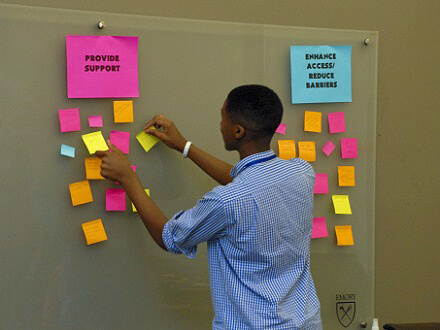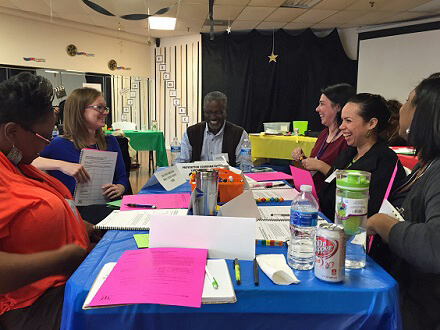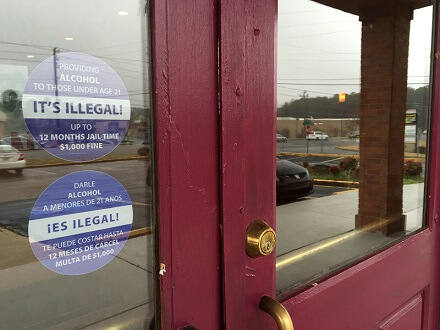 This summer at Georgia Teen Institute, we talked a lot about CADCA’s Seven Strategies for Community Change and how they are used to change conditions and improve health and safety in our communities. We also discussed ways to incorporate them into prevention projects.
This summer at Georgia Teen Institute, we talked a lot about CADCA’s Seven Strategies for Community Change and how they are used to change conditions and improve health and safety in our communities. We also discussed ways to incorporate them into prevention projects.
These strategies are important when it comes to substance abuse prevention because they discourage alcohol and substance abuse among youth and can help change the environment, which leads to changing attitudes, social norms and alcohol/drug use behavior.
Before you get started planning your next project, remember that the strategies below build from good to better to best. You can affect more people and make a larger impact if you focus on the environmental change strategies!
Individual Change Strategies
1. PROVIDING INFORMATION – Educational presentations, workshops or other data presentations (e.g., public announcements, brochures, community meetings or social media).
One way we provide information at GUIDE is by spreading awareness about underage drinking prevention through Public Service Announcements at local Department of Motor Vehicles and on TVgwinnett, the local TV station.
 2. BUILDING SKILLS – Workshops or other activities designed to increase the skills of participants, members and staff needed to achieve population-level outcomes (e.g., training, technical assistance, distance learning, strategic planning retreats and curricula development).
2. BUILDING SKILLS – Workshops or other activities designed to increase the skills of participants, members and staff needed to achieve population-level outcomes (e.g., training, technical assistance, distance learning, strategic planning retreats and curricula development).
GUIDE provides several local and statewide youth and professional development trainings each year.
3. PROVIDING SUPPORT – Creating opportunities to support people to participate in activities that reduce risk or enhance protection (e.g., providing alternative activities, mentoring, referrals, support groups or clubs).
GUIDE provides support to several Youth Action Teams around the state and has partnered with others in the community to offer alternative activities for youth throughout the year.
Environmental Change Strategies
4. ENHANCING ACCESS/REDUCING BARRIERS – Improving systems and processes to increase the ease, ability and opportunity to utilize those systems and services (e.g., ensuring childcare, transportation, safety, special needs and cultural and language sensitivity).
When implementing projects and campaigns, GUIDE works with agencies that serve the diverse cultures in the community to make sure materials are available in other languages and to accommodate all the various needs.
5. CHANGING CONSEQUENCES (INCENTIVES/DISINCENTIVES) – Increasing or decreasing the probability of a specific behavior that reduces risk or enhances protection by altering the consequences for performing that behavior (e.g., increasing public recognition for deserved behavior, individual and business rewards, scholarships, citations, fines or revocations/loss of privileges).
GUIDE works with local police departments to enforce safe alcohol sales and conduct compliance checks to make sure employees at alcohol retailers are checking IDs. If an employee sells alcohol to an underage decoy, he or she receives a citation and has to pay a fine.
 6. PHYSICAL DESIGN – Changing the physical design or structure of the environment to reduce risk or enhance protection (e.g., parks, landscapes, signage, lighting or outlet density).
6. PHYSICAL DESIGN – Changing the physical design or structure of the environment to reduce risk or enhance protection (e.g., parks, landscapes, signage, lighting or outlet density).
GUIDE provides glass clings and posters with warning messages to alcohol retailers that are placed on doors and walls in the store to remind adults not to provide alcohol to minors and outline the consequences for breaking this law.
7. MODIFYING/CHANGING POLICY – Formal change in written procedures, by-laws, proclamations, rules or laws with written documentation and/or voting procedures (e.g., workplace initiatives, law enforcement procedures and practices, public policy actions and systems change within government, communities and organizations).
GUIDE recently collaborated with the City of Duluth to create an Alcohol Awareness Training for all owners, managers, servers and handlers of alcohol in the city. The city passed an ordinance to mandate the training.
For additional examples of these strategies, take a look at skits created and performed by our Youth Advisory Board members!
